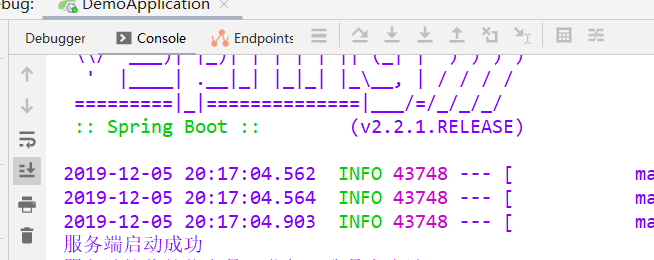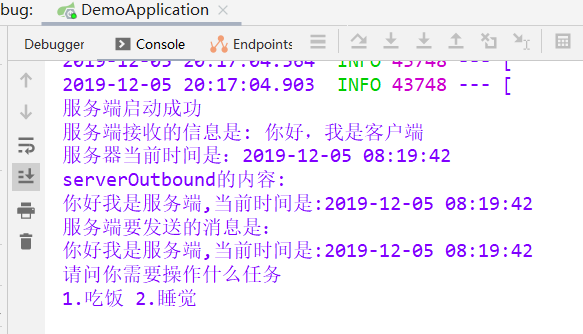Netty学习第四章 spring boot整合netty的使用
现在大多数项目都是基于spring boot进行开发,所以我们以spring boot作为开发框架来使用netty。使用spring boot的一个好处就是能给将netty的业务拆分出来,并通过spring cloud整合到项目中。
我们以一个简单的客户端发送消息到服务的场景编写一个实例。
一、服务端模块
netty中服务端一般分为两个类,一个是启动配置类,另一个是消息的逻辑处理类,但是首先我们要配置spring boot的启动类,启动netty
@SpringBootApplication public class DemoApplication implements CommandLineRunner { @Autowired NettyServer nettyServer; public static void main(String[] args) { SpringApplication.run(DemoApplication.class, args); } @Override public void run(String... args) throws Exception { nettyServer.startServer(); } }
1.启动配置类
import io.netty.bootstrap.ServerBootstrap; import io.netty.channel.*; import io.netty.channel.nio.NioEventLoopGroup; import io.netty.channel.socket.SocketChannel; import io.netty.channel.socket.nio.NioServerSocketChannel; import org.springframework.beans.factory.annotation.Autowired; import org.springframework.context.annotation.Configuration; /** * Netty * 服务端 */ @Configuration public class NettyServer { //四个处理请求的逻辑类 @Autowired ServerInboundHandler serverInboundHandler; @Autowired ServerInboundGetTimeHandler serverInboundGetTimeHandler; @Autowired ServerLastOutboundHandler serverLastOutboundHandler; @Autowired ServerOutboundHandler serverOutboundHandler; public void startServer() { System.out.println("服务端启动成功"); //创建两个线程组,用于接收客户端的请求任务,创建两个线程组是因为netty采用的是反应器设计模式 //反应器设计模式中bossGroup线程组用于接收 EventLoopGroup bossGroup = new NioEventLoopGroup(); //workerGroup线程组用于处理任务 EventLoopGroup workerGroup = new NioEventLoopGroup(); //创建netty的启动类 ServerBootstrap bootstrap = new ServerBootstrap(); //创建一个通道 ChannelFuture f = null; try { bootstrap.group(bossGroup, workerGroup) //设置线程组 .channel(NioServerSocketChannel.class) //设置通道为非阻塞IO .option(ChannelOption.SO_BACKLOG, 128) //设置日志 .option(ChannelOption.SO_RCVBUF, 32 * 1024) //接收缓存 .childOption(ChannelOption.SO_KEEPALIVE, true)//是否保持连接 .childHandler(new ChannelInitializer<SocketChannel>() { //设置处理请求的逻辑处理类 @Override protected void initChannel(SocketChannel ch) throws Exception { //ChannelPipeline是handler的任务组,里面有多个handler ChannelPipeline pipeline = ch.pipeline(); //逻辑处理类 pipeline.addLast(serverLastOutboundHandler); pipeline.addLast(serverOutboundHandler); pipeline.addLast(serverInboundHandler); pipeline.addLast(serverInboundGetTimeHandler); } }); f = bootstrap.bind(84).sync();//阻塞端口号,以及同步策略 f.channel().closeFuture().sync();//关闭通道 } catch (InterruptedException e) { e.printStackTrace(); } finally { //优雅退出 bossGroup.shutdownGracefully(); workerGroup.shutdownGracefully(); } } }
2.启动配置类中的各个组件
1)EventLoop 与 EventLoopGroup
EventLoop 好比一个线程,1个EventLoop 可以服务多个channel,而一个channel只会有一个EventLoop 。EventLoop 在netty中就是负责整个IO操作,包括从消息的读取、编码以及后续 ChannelHandler 的执行,这样做的好处就是避免了线程中的上下文切换时,大量浪费资源情况。
EventLoopGroup 是负责分配EventLoop到新创建的channel,EventLoopGroup 就好比线程池,它里面包含多个EventLoop。
2)BootStrap
BootStrap 是netty中的引导启动类也就是一个工厂配置类,可以通过它来完成 Netty 的客户端或服务器端的 Netty 初始化,所以我们主要来看它的几个常用的配置方法。
① gruop() 方法
gruop()方法用于配置netty中的线程组,也就是我们的EventLoopGroup ,在服务端中需要配置两个线程组,这是因为netty中采用的是反应器设计模式(reactor ),我们知道反应器设计模式中是需要两个线程组,一个用于接收用户的请求,另一个用于处理请求的内容。
② channel() 方法
channel()方法用于配置通道的IO类型,IO类型有两个:阻塞IO(BIO)OioServerSocketChannel;非阻塞IO(NIO)NioServerSocketChannel。
③ childHandler () 方法
用于设置处理请求的适配器,这个在下面详细介绍。
④ childOption() 方法
给每条child channel连接设置一些TCP底层相关的属性,比如上面,我们设置了两种TCP属性,其中 ChannelOption.SO_KEEPALIVE表示是否开启TCP底层心跳机制,true为开
⑤ option
给每条parent channel 连接设置一些TCP底层相关的属性。
关于option的属性有:
SO_RCVBUF ,SO_SNDBUF:用于设置TCP连接中使用的两个缓存区。
TCP_NODELAY:立即发送数据,采用的是Nagle算法。Nagle算法是当小数据过多时,就会将这些小数据碎片连接成更大的报文,从而保证发送的报文数量最小。所以如果数据量小就要禁用这个算法,netty默认是禁用的值为true。
通俗地说,如果要求高实时性,有数据发送时就马上发送,就关闭,如果需要减少发送次数减少网络交互,就开启。
SO_KEEPALIVE:底层TCP协议的心跳机制。Socket参数,连接保活,默认值为False。启用该功能时,TCP会主动探测空闲连接的有效性。
SO_REUSEADDR:Socket参数,地址复用,默认值False
SO_LINGER:Socket参数,关闭Socket的延迟时间,默认值为-1,表示禁用该功能。
SO_BACKLOG:Socket参数,服务端接受连接的队列长度,如果队列已满,客户端连接将被拒绝。默认值,Windows为200,其他为128。
SO_BROADCAST:Socket参数,设置广播模式。
3)ChannelFuture
我们知道netty中的所有IO操作都是异步的,这意味着任何IO调用都会立即返回,不管结果如果状态如果。而ChannelFuture 的存在就是为了解决这一问题,它会提供IO操作中有关的信息、结果或状态。
ChannelFuture 一共有两个状态:
未完成状态:当IO操作开始时,将创建一个新的ChannelFuture 对象,此时这个对象既没有操作成功也没有失败,那么就说这个对象就是未完成的状态。简单来说未完成指创建了对象且没有完成IO操作。
已完成状态:当IO操作完成后,不管操作是成功还是失败,future都是标记已完成的,失败时也会有对应的具体失败信息。
3.消息逻辑处理类
可以看到我一共在pipeline里面配置了4个handler,这是为了查看inboundhandler和outboundhandler的数据传递方式,以及每个handler的执行顺序
ServerInboundGetTimeHandler:
import io.netty.buffer.ByteBuf; import io.netty.buffer.Unpooled; import io.netty.channel.ChannelHandlerContext; import io.netty.channel.ChannelInboundHandlerAdapter; import org.springframework.context.annotation.Configuration; import java.text.SimpleDateFormat; import java.util.Date; /** * Inbound处理类 * 给客户端返回一个时间戳 */ @Configuration public class ServerInboundGetTimeHandler extends ChannelInboundHandlerAdapter { /** * 获取客户端的内容类 * @param ctx * @param msg * @throws Exception */ @Override public void channelRead(ChannelHandlerContext ctx, Object msg) throws Exception { //将传递过来的内容转换为ByteBuf对象 ByteBuf buf = (ByteBuf) msg; //和文件IO一样,用一个字节数组读数据 byte[] reg = new byte[buf.readableBytes()]; buf.readBytes(reg); //将读取的数据转换为字符串 String body = new String(reg, "UTF-8"); //给客户端传递的内容,同样也要转换成ByteBuf对象 Date dNow = new Date( ); SimpleDateFormat ft = new SimpleDateFormat ("yyyy-MM-dd hh:mm:ss"); String respMsg = body+ft.format(dNow); System.out.println("服务器当前时间是:"+ft.format(dNow)); ByteBuf respByteBuf = Unpooled.copiedBuffer(respMsg.getBytes()); //调用write方法,通知并将数据传给outboundHand ctx.write(respByteBuf); } /** * 刷新后才将数据发出到SocketChannel * @param ctx * @throws Exception */ @Override public void channelReadComplete(ChannelHandlerContext ctx) throws Exception { ctx.flush(); } /** * 关闭 * @param ctx * @param cause * @throws Exception */ @Override public void exceptionCaught(ChannelHandlerContext ctx, Throwable cause) throws Exception { cause.printStackTrace(); ctx.close(); } }
ServerInboundHandler:
import io.netty.buffer.ByteBuf; import io.netty.buffer.Unpooled; import io.netty.channel.ChannelHandler; import io.netty.channel.ChannelHandlerContext; import io.netty.channel.ChannelInboundHandlerAdapter; import org.springframework.context.annotation.Configuration; /** * Inbound处理类,是用来处理客户端发送过来的信息 * Sharable 所有通道都能使用的handler */ @Configuration @ChannelHandler.Sharable public class ServerInboundHandler extends ChannelInboundHandlerAdapter { /** * 获取客户端的内容类 * @param ctx * @param msg * @throws Exception */ @Override public void channelRead(ChannelHandlerContext ctx, Object msg) throws Exception { //将传递过来的内容转换为ByteBuf对象 ByteBuf buf = (ByteBuf) msg; //和文件IO一样,用一个字节数组读数据 byte[] reg = new byte[buf.readableBytes()]; buf.readBytes(reg); //将读取的数据转换为字符串 String body = new String(reg, "UTF-8"); System.out.println( "服务端接收的信息是: " + body); //给客户端传递的内容,同样也要转换成ByteBuf对象 String respMsg = "你好我是服务端,当前时间是:"; ByteBuf respByteBuf = Unpooled.copiedBuffer(respMsg.getBytes()); //调用fireChannelRead方法,通知并将数据传给下一个handler ctx.fireChannelRead(respByteBuf); } /** * 刷新后才将数据发出到SocketChannel * @param ctx * @throws Exception */ @Override public void channelReadComplete(ChannelHandlerContext ctx) throws Exception { ctx.flush(); } /** * 关闭 * @param ctx * @param cause * @throws Exception */ @Override public void exceptionCaught(ChannelHandlerContext ctx, Throwable cause) throws Exception { cause.printStackTrace(); ctx.close(); } }
ServerLastOutboundHandler:
import io.netty.buffer.ByteBuf; import io.netty.buffer.Unpooled; import io.netty.channel.ChannelHandlerContext; import io.netty.channel.ChannelOutboundHandlerAdapter; import io.netty.channel.ChannelPromise; import org.springframework.context.annotation.Configuration; /** * Outbound表示服务器发送的handler */ @Configuration public class ServerLastOutboundHandler extends ChannelOutboundHandlerAdapter { /** * 服务端要传递消息的方法 * @param ctx * @param msg * @param promise * @throws Exception */ @Override public void write(ChannelHandlerContext ctx, Object msg, ChannelPromise promise) throws Exception { //将传递过来的内容转换为ByteBuf对象 ByteBuf buf = (ByteBuf) msg; //和文件IO一样,用一个字节数组读数据 byte[] reg = new byte[buf.readableBytes()]; buf.readBytes(reg); String body=new String(reg,"UTF-8"); String respMsg = body+"\n1.吃饭 2.睡觉"; System.out.println("服务端要发送的消息是:\n"+respMsg); ByteBuf respByteBuf = Unpooled.copiedBuffer(respMsg.getBytes()); ctx.write(respByteBuf); ctx.flush(); //ctx.write()方法执行后,需要调用flush()方法才能令它立即执行 } }
ServerOutboundHandler:
import io.netty.buffer.ByteBuf; import io.netty.buffer.Unpooled; import io.netty.channel.ChannelHandlerContext; import io.netty.channel.ChannelOutboundHandlerAdapter; import io.netty.channel.ChannelPromise; import org.springframework.context.annotation.Configuration; /** * Outbound表示服务器发送的handler */ @Configuration public class ServerOutboundHandler extends ChannelOutboundHandlerAdapter{ /** * 服务端要传递消息的方法 * @param ctx * @param msg * @param promise * @throws Exception */ @Override public void write(ChannelHandlerContext ctx, Object msg, ChannelPromise promise) throws Exception { //将传递过来的内容转换为ByteBuf对象 ByteBuf buf = (ByteBuf) msg; //和文件IO一样,用一个字节数组读数据 byte[] reg = new byte[buf.readableBytes()]; buf.readBytes(reg); String body=new String(reg,"UTF-8"); System.out.println("serverOutbound的内容:\n"+body); String respMsg = body+"\n请问你需要操作什么任务"; ByteBuf respByteBuf = Unpooled.copiedBuffer(respMsg.getBytes()); ctx.write(respByteBuf); ctx.flush(); //ctx.write()方法执行后,需要调用flush()方法才能令它立即执行 } }
4.channelHandler中的各个组件
1)channel
channel的本质就是一个socket连接,是服务端与客户端连接的通道。channel除了连接客户端与服务端外,还能监控通道的状态,如:什么时候传输、传输完成情况都能监控到。
channel的一个有四个状态:
channelReistered:channel注册到一个EventLoop,此时为注册状态
channelUnregistered:channel已经创建好了还未进行注册,此时为未注册状态
channelActive:客户端与服务端连接后,channel会变为活跃状态,此时可以接收和发送数据
channelInactive:非活跃状态,没有连接远程主机的时候。
channel的生命周期状态变化大致如图:

2)channelHandler
channelHandler就是我们处理数据逻辑的地方,它一共分为两大类:InboundHandler和呕Outboundhandler。InboundHandler用于处理输入的数据和改变channel状态类型,OutboundHandler用于回写给外界的数据。
channelHandler的执行顺序:
InboundHandler:顺序执行
OutboundHandler:逆序执行
在channelHandler的执行过程中,InboundHandler会覆盖后面的OutboundHandler,所以在开发中应该先执行OutboundHandler再执行InboundHandler
3)channelPipeline
管理channelHandler的有序容器,它里面可以有多个channelHandler。
channel、channelHandler、channelPipeline三者的关系:
一个channel有一个容器channelPipeline,容器中有多个channelHandler。创建channel时会自动创建一个channelPipeline,每个channel都有一个管理它的channelPipeline,这个关联是永久的。
二、客户端代码
netty中客户端的各个组件都是和服务端一样的,所以不用再介绍客户端的组件
1.配置类代码
import io.netty.bootstrap.Bootstrap; import io.netty.channel.ChannelFuture; import io.netty.channel.ChannelInitializer; import io.netty.channel.EventLoopGroup; import io.netty.channel.nio.NioEventLoopGroup; import io.netty.channel.socket.SocketChannel; import io.netty.channel.socket.nio.NioSocketChannel; import org.springframework.context.annotation.Configuration; import java.net.InetSocketAddress; /** * netty 客户端类 */ @Configuration public class NettyClient { public static void main(String[] args) { //客户端只需要创建一个线程就足够了 EventLoopGroup group = new NioEventLoopGroup(); try { //客户端启动类 Bootstrap bootstrap = new Bootstrap(); bootstrap.group(group)//设置线程组 .channel(NioSocketChannel.class)//设置通道类型 .remoteAddress(new InetSocketAddress("127.0.0.1", 84))//设置IP和端口 .handler(new ChannelInitializer<SocketChannel>() { @Override protected void initChannel(SocketChannel socketChannel) throws Exception { socketChannel.pipeline().addLast(new ClientHandler()); } }); //阻塞通道 ChannelFuture channelFuture = bootstrap.connect().sync(); channelFuture.channel().closeFuture().sync(); } catch (Exception e) { } finally { group.shutdownGracefully(); } } }
2.逻辑处理类代码
import io.netty.buffer.ByteBuf; import io.netty.buffer.Unpooled; import io.netty.channel.ChannelHandlerContext; import io.netty.channel.SimpleChannelInboundHandler; import io.netty.util.CharsetUtil; /** * 客户端逻辑处理类 */ public class ClientHandler extends SimpleChannelInboundHandler<ByteBuf> { /** * 发送给服务器消息的方法 * @param ctx * @throws Exception */ @Override public void channelActive(ChannelHandlerContext ctx) throws Exception { ctx.writeAndFlush(Unpooled.copiedBuffer("你好,我是客户端", CharsetUtil.UTF_8)); } /** * 回调方法,接收服务器发送的消息 * @param ctx * @param msg * @throws Exception */ @Override protected void channelRead0(ChannelHandlerContext ctx, ByteBuf msg) throws Exception { System.out.println( msg.toString(CharsetUtil.UTF_8)); } /** * 在处理过程中引发异常时被调用 * @param ctx * @param cause * @throws Exception */ @Override public void exceptionCaught(ChannelHandlerContext ctx, Throwable cause) throws Exception { cause.printStackTrace(); ctx.close(); } }
测试结果,先启动服务端:

然后启动客户端:

最后再来看看服务端:



